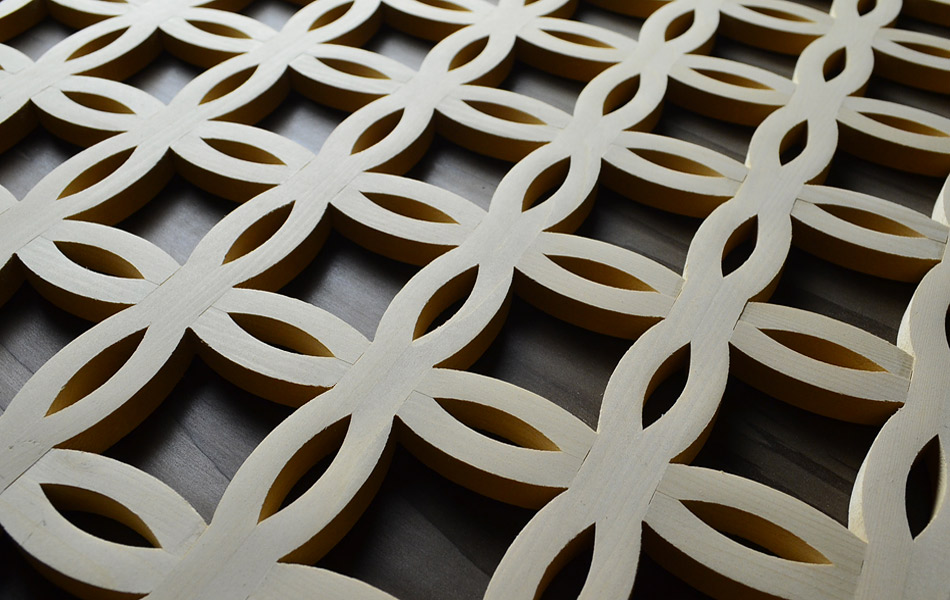
A few weeks ago we introduced you to the world of traditional Japanese woodwork, a technique that uses no nails or hardware, just precise joints, to keep furniture and even buildings together. This technique is also used to create intricate, wooden, functional artwork, known as kumiko, which is used within Japanese style-rooms to create a stunning atmosphere.
The traditional handicraft has been passed down for centuries, however, the trade is sadly dying out. In response, artisans are taking the age-old concept and applying the designs to more modern-day household items, such as chairs and lampshades. The results are nothing short of exquisite!
According to Tanihata Co., a kumiko workshop in Toyama Prefecture, kumiko has been around since the Asuka era (600-700 AD). The craft was originally used almost exclusively for sliding doors, room dividers and ramma (the decorative wooden piece above many doors in traditional Japanese buildings). While providers like Tanihata still make these products, modernization has brought a decrease in demand for such traditional room components, so craftsmen are broadening their horizons.
▼ Ramma, the decorative section above doors and walls
Regardless of what they are making, the time and care put into each piece never changes. If you thought making buildings and furniture in the traditional Japanese style was painstaking, prepared to be wowed.
Just like furniture-makers, kumiko artists are very particular about the wood they use. While, it’s easier to use mass-produced particle board, you lose the ability to be as precise, the elegant atmosphere of real wood, and of course, the great smell! When choosing wood, they prefer to use that of coniferous trees, namely cedar and cypress, because they grow straight and the wood has a high-quality fine grain.
▼ Kumiko is often made of wood from tall, thin, Japanese cypress trees.
Once the wood is picked out, cut and planed, they make the frame for the piece, whether it be a coaster or a ceiling lampshade. Next comes the difficult and intricate part of the process, which makes kumiko what it is. Hundreds of small pieces of wood are thinly sliced and shaved with a variety of tools, such as old-fashioned knives and saws, plus new machinery too. These tiny pieces have to be precisely cut down to the micron (1/1000 mm) or they won’t fit together perfectly! Once cut, the pieces are carefully assembled by being slid into place in an elaborate design within the frame.
▼ A variety of machinery and hand-tools are used to make and assemble the delicate pieces.
The designs for kumiko pieces aren’t chosen randomly. In fact, many of the nearly 200 patterns used today have been around since the Edo era (1603-1868). Each design has a meaning or is mimicking a pattern in nature that is thought to be a good omen. The designs are not just pretty, they also distribute light and wind in a calming and beautiful way.
▼ The Shippou design. In Buddhist scripture, shippou refers to a set of treasures (which includes gold, silver, lapis lazuli, quartz, coral and agate), and the never-ending, circular design represents harmony.
▼ The goma design is suggestive of nutritional and abundant sesame flowers, which are thought to promote longevity. This design is often used for ramma.
▼ Sanjyu-hifu is a design that utilizes thin strips to create diamond shapes. It’s thought to mimic very fertile water plants, a good omen for prosperous offspring and good health. With this is mind, sanjyu-hifu is often used in hotels and wedding halls.
▼ The Asanoha pattern takes after the hemp leaf. Hemp plants are known for growing quickly and straight-up, as well as for being sturdy plants. For this reason, the design has come to be used commonly with baby clothes too.
▼ These are some of the more common designs.
As we mentioned earlier, artisans are turning their focus to bringing their trade to the modern world, while still sticking with the traditional roots of kumiko. With this in mind, they have been creating beautiful art that can be used on a daily basis in any home.
▼ What a beautiful casing for a ceiling light.
▼ You can even get kumiko chairs!
▼ This lamp makes really cool shadows!
▼ It kind of has a disco-ball feel.
Due to the drop in demand for traditional Japanese interior decoration, such as ramma, the kumiko trade has also seen a decrease in the number of young craftsmen. But hopefully, with the technique being applied to modern living, more young people will step up to the challenge and carry on this intricate and beautiful craft for future generations.
Source: Naver Matome, TanihataImages: Tanihata (1, 6, 7, 8, 9); Yoshihara Woodworks (2, 3, 10); Wikimedia Commons (陳炬燵 4 ), Kinoshita Mokugei (5); Musabi (11); Interior-is (12); Y-brand (13)